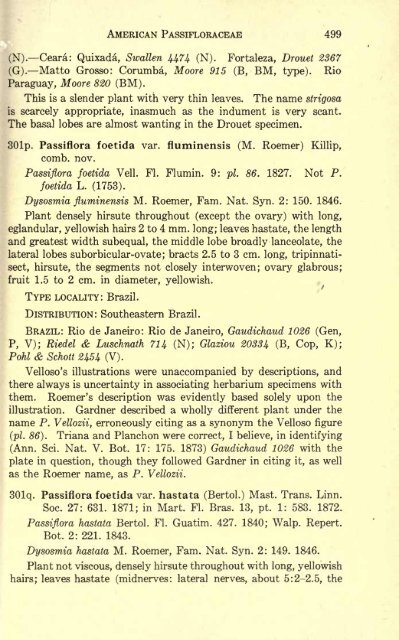downloads/Killip 2.pdf - Passion Flowers
downloads/Killip 2.pdf - Passion Flowers
downloads/Killip 2.pdf - Passion Flowers
Create successful ePaper yourself
Turn your PDF publications into a flip-book with our unique Google optimized e-Paper software.
AMERICAN PASSIFLORACEAE 499<br />
(N). Ceara: Quixada, Swollen 4474 (N). Fortaleza, Drouet 2367<br />
(G). Matto Grosso: Corumba, Moore 915 (B, BM, type). Rio<br />
Paraguay, Moore 820 (BM).<br />
This is a slender plant with very thin leaves. The name strigosa<br />
is scarcely appropriate, inasmuch as the indument is very scant.<br />
The basal lobes are almost wanting in the Drouet specimen.<br />
301p. Passiflora foetida var. fluminensis (M. Roemer) <strong>Killip</strong>,<br />
comb. nov.<br />
Passiflora foetida Veil. Fl. Flumin. 9: pi. 86. 1827. Not P.<br />
foetida L. (1753).<br />
Dysosmia fluminensis M. Roemer, Fam. Nat. Syn. 2: 150. 1846.<br />
Plant densely hirsute throughout (except the ovary) with long,<br />
eglandular, yellowish hairs 2 to 4 mm. long; leaves hastate, the length<br />
and greatest width subequal, the middle lobe broadly lanceolate, the<br />
lateral lobes suborbicular-ovate; bracts 2.5 to 3 cm. long, tripinnatisect,<br />
hirsute, the segments not closely interwoven; ovary glabrous;<br />
fruit 1.5 to 2 cm. in diameter, yellowish.<br />
TYPE LOCALITY: Brazil.<br />
DISTRIBUTION: Southeastern Brazil.<br />
BRAZIL: Rio de Janeiro: Rio de Janeiro, Gaudichaud 1026 (Gen,<br />
P, V); Riedel & Luschnath 714 (N); Glaziou 20384 (B, Cop, K);<br />
Pohl & Schott 2454 (V).<br />
Velloso's illustrations were unaccompanied by descriptions, and<br />
there always is uncertainty in associating herbarium specimens with<br />
them.<br />
Roemer's description was evidently based solely upon the<br />
illustration. Gardner described a wholly different plant under the<br />
name P. Vellozii, erroneously citing as a synonym the Velloso figure<br />
(pi. 86). Triana and Planchon were correct, I believe, in identifying<br />
(Ann. Sci. Nat. V. Bot. 17: 175. 1873) Gaudichaud 1026 with the<br />
plate in question, though they followed Gardner in citing it, as well<br />
as the Roemer name, as P. Vellozii.<br />
301q. Passiflora foetida var. hastata (Bertol.) Mast. Trans. Linn.<br />
Soc. 27: 631. 1871; in Mart. Fl. Bras. 13, pt. 1: 583. 1872.<br />
Passiflora hastata Bertol. Fl. Guatim. 427. 1840; Walp. Repert.<br />
Bot. 2: 221. 1843.<br />
Dysosmia hastata M. Roemer, Fam. Nat. Syn.<br />
2: 149. 1846.<br />
Plant not viscous, densely hirsute throughout with long, yellowish<br />
hairs; leaves hastate (midnerves: lateral nerves, about 5:2-2.5, the
















